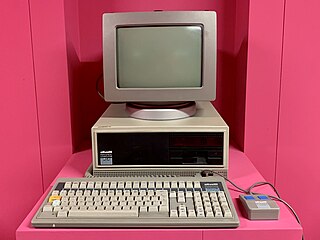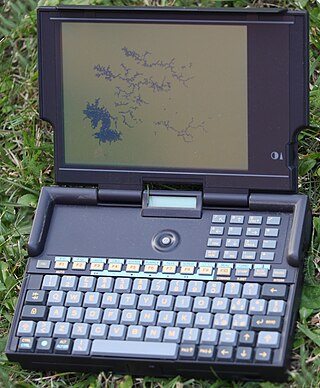
The Intel 80186, also known as the iAPX 186, or just 186, is a microprocessor and microcontroller introduced in 1982. It was based on the Intel 8086 and, like it, had a 16-bit external data bus multiplexed with a 20-bit address bus. The 80188 variant, with an 8-bit external data bus was also available.

The Matra & Hachette Ordinateur Alice is a home computer sold in France beginning in 1983. It was a clone of the TRS-80 MC-10, produced through a collaboration between Matra and Hachette in France and Tandy Corporation in the United States.

The ThomsonMO5 is a home computer introduced in France in June 1984 to compete against systems such as the ZX Spectrum and Commodore 64. It had a release price of 2390 FF.

Olivetti S.p.A. is an Italian manufacturer of computers, tablets, smartphones, printers and other such business products as calculators and fax machines. Headquartered in Ivrea, in the Metropolitan City of Turin, the company has been part of the TIM Group since 2003. One of the first commercial programmable desktop calculators, the Programma 101, was produced by Olivetti in 1964 and was a commercial success.

Micral is a series of microcomputers produced by the French company Réalisation d'Études Électroniques, beginning with the Micral N in early 1973. The Micral N was the first commercially available microprocessor-based computer.

The Olivetti M19 was a personal computer made in 1986 by the Italian company Olivetti. It has an 8088 at 4.77 or 8 MHz and 256–640 KB of RAM. The BIOS is Revision Diagnostics 3.71. In the UK, it was sold by Acorn Computers as the Acorn M19, with additional software also available via Acorn. In France, it was available as the Persona 1300, sold by LogAbax.

The Olivetti M24 is a computer that was sold by Olivetti in 1983 using the Intel 8086 CPU.

The Thomson TO7, also called Thomson 9000 is a home computer introduced by Thomson SA in November 1982, with an original retail price of 3750 FF. By 1983 over 40000 units were produced. About 84 games were released for the TO7.

The VG5000μ is a computer created by Philips in 1984. It was manufactured in Le Mans by Radiotechnique (RTS) and marketed under the Philips, Radiola and Schneider brands.

In the 1980s the French Thomson company produced a range of 8-bit computers based on the 6809E CPU.

The Quaderno was a subnotebook, produced by Olivetti in two versions from 1992: Quaderno (PT-XT-20) and Quaderno 33 (PT-AT-60).
The Olivetti company, an Italian manufacturer of computers, tablets, smartphones, printers and other such business products as calculators and fax machines, was founded as a typewriters manufacturer by Camillo Olivetti in 1908 in the Turin commune of Ivrea, Italy. Olivetti was a pioneer in computer development, starting with the mainframe systems in the 1950s, and continuing into the 1990s with PC compatible laptops and desktops.
Toshiba Pasopia 16 or PA7020 is an IBM PC compatible computer from manufacturer Toshiba, released in 1982 and based around a Intel 8088-2 microprocessor running at 6 MHz. It's also known as T300 on the US and PAP in Europe.
The Computing for All plan was a French government plan to introduce computers to the country's 11 million pupils. A second goal was to support national industry. It followed several introductory computer science programs in schools since 1971. The IPT plan was presented to the press on January 25, 1985 by Laurent Fabius, Prime Minister at the time. It aimed to set up, from the start of that school year, more than 120,000 machines in 50,000 schools and to train 110,000 teachers. Its estimated cost was 1.8 billion francs, including 1.5 billion for equipment. The plan was abandoned in 1989.
The EXL 100 is a computer released in 1984 by the French brand Exelvision, based on the TMS 7020 microprocessor from Texas Instruments. This was an uncommon design choice but justified by the fact that the engineering team behind the machine came from Texas instruments. It was part of the government Computing for All plan and 9000 units were used in schools.

The Olivetti M28, introduced in 1986, was the successor to the Olivetti M24. It had an Intel 80286 CPU running at 8 MHz and 512 KB of RAM, featuring a 5.25" floppy drive and a 20 MB hard drive. The operating systems were MS-DOS 3.2 and XENIX. The computer had room to install three disk units, as opposed to only two on the M24. It was possible to install a 70 MB hard drive, a 80287 math co-processor and a enhanced CGA compatible graphic card capable of displaying 640x400 pixels with 16 colors.
Hector are a series of a microcomputers produced in France in the early 1980s.

SMT Goupil was a French IT company created in 1979 by Claude Perdrillat, previously a senior executive in the General Directorate of Telecommunications.
Léanord was a French computer brand, founded in 1960 at Haubourdin, near Lille. It was a subsidiary of Creusot-Loire and started to develop computers in the late 1970s.
The Micromega 32 was a Motorola 68000-based machine running MIMOS, the French version Version 7 Unix, released in 1982 by the French company Thomson SA. It is based on the Fortune 32:16, developed by Fortune Systems Corp. The machine was presented to the public at the 1982 Salon des industries et du commerce de bureau (SICOB) in the Paris Expo Porte de Versailles.














